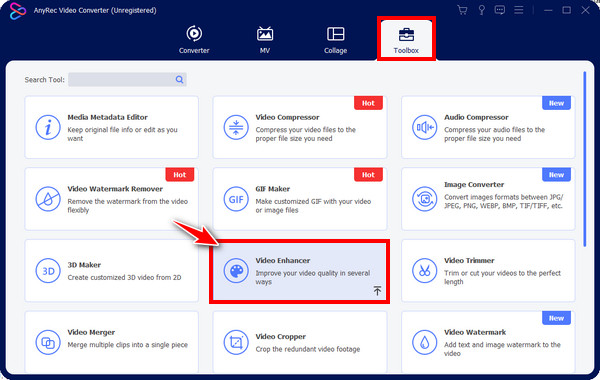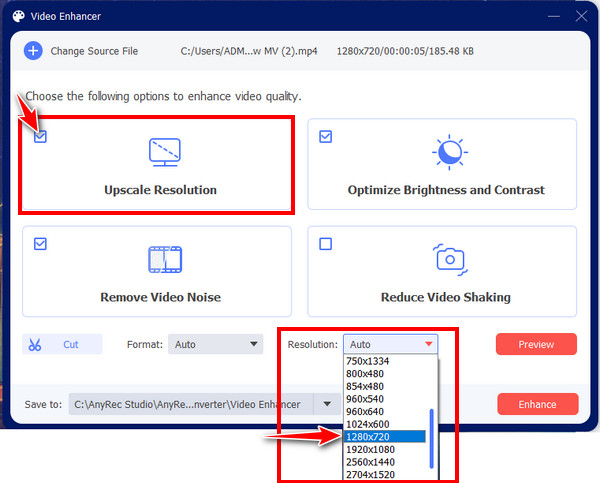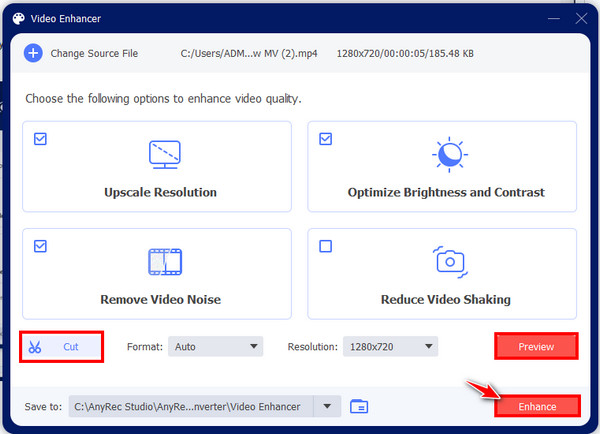A Guide to SD vs. HD: Which One is Better for Your Video?
A good video quality allows viewers to have an enjoyable watching experience; thus, to make this happen, it’s vital to learn about the video resolution, mainly about SD vs. HD. If you’re confused about the two, you may see their differences when you watch TV. But what about live streaming and other online contents? To know which is preferable for what platforms, you can look at this SD versus HD post, covering their differences, usage, and more.
Guide List
What are SD and HD Resolutions? Differences between SD VS. HD: Which One to Choose? How to Upscale SD to HD with Higher Quality FAQsWhat are SD and HD Resolutions?
To have a better start in the comparison of SD VS. HD, you should know what video resolution is. Simply put, the more numbers, the clearer the details of the video will be. That’s how video resolution works in pixels, which are the single points of color that, once combined, will form an image. As streaming content advanced so much, people undoubtedly embraced the wider and higher resolutions that are ideal for TV displays and online video content.
So, for those who are into producing video content, here are the four common video resolutions used today you can consider.
- SD: 720 x 480
- HD: 1280 x 720
- Full HD: 1920 x 1080
- 4K Ultra HD: 3480 x 2160
Among those four, SD and HD are the most used for many cases. Thus, there’s always a question about the difference between HD and SD. But before diving into that, take a glimpse at what SD and HD resolutions are.
What is SD?
Stands for Standard Definition and has 480 pixels; SD has been useful for live streaming for years now, as it demands less bandwidth, thus offering a reliable and straight streaming experience.
Although it may be considered low in resolution compared to HD, it is very useful for keeping your videos playing, even if you have an unstable connection. Also, it is a primary choice if the higher resolution download speed is too slow and when you’re watching on a smaller screen.
What is HD?
On the other hand, HD is for High-Definition videos that produce more details and sharper video than SD. It uses a 16:9 aspect ratio, 720 or 1080 pixels, and is excellent for online video and streaming; it can also be your ideal option when you live stream to your social media accounts.
For 720p, it is thought of as Standard HD, the basic one for streaming; meanwhile, 1080p is referred to as Full HD, which is mainly for video and streams that require higher quality. Concerning it being much higher than SD, be sure to check your internet bandwidth.
Differences between SD VS. HD: Which One to Choose?
Now, surely you have a better understanding of the two said resolutions. To proceed to this SD vs. HD comparison post, you already see the main factors that differ between the two, it is the video quality and required bandwidth.
But, to help you decide which one to choose for your video in-line to be uploaded, here’s a brief discussion of the Standard Definition vs. High Definition.
SD vs. HD: Video Quality
SD provides a lower-quality watching experience where the resolution is 480p. And even if it holds more detail and offers more clarity than 360p and below, it still isn’t the ideal selection for a superb viewing experience. By that, HD resolution is the one that stands out here as it guarantees a higher image quality, clearer colors, detailed images, and clarity. Therefore, it is worth settling for HD streaming, whether for YouTube content, live streaming, or other videos.
SD vs. HD: Internet Bandwidth Consumption
As noted earlier, HD demands more bandwidth as you need to watch videos at a higher bit rate. For instance, you’re required to have an internet speed of 25 Mbps and higher to watch 1080p HD, so if you have an unstable connection, don’t expect to have a smooth HD-watching experience. For 720p videos, at least 10 Mbps is needed, while 5 MBps is needed for 480p videos. Therefore, if you are not that keen on higher resolution and mostly suffer from poor internet speed, then SD is the better choice here. However, as you know, most mobile devices and video streaming are progressively moving beyond the SD resolution, so you may get ready for adaptations so as not to feel left out once everyone uses HD streaming.
SD vs. HD: Streaming Platforms
Today, most platforms, unsurprisingly, offer superb resolution video content. So, HD is ahead of the game here, yet higher resolutions result in slow downloading speed, making SD a choice for some viewers, especially if they love offline viewing.
SD vs. HD: File Size
Regarding the file size, please know that a higher resolution implies a huge file size, which is required for a bigger storage capacity and higher power processor. And, as understood, HD is much higher than SD; thus, it could be a downside for you if you are opting for HD streaming while working with a lower capacity and outdated devices.
Which One is Best? HD or SD?
Coming to answer the fight between SD vs. HD, which one to choose for your video content, the ideal option is to go for a higher resolution. But you have much to consider, so the decision falls to your available connection, speed, and computer requirements. When convenience and affordability are concerned, SD streaming is clearly the one for you.
At the same time, opt for HD streaming if you and your target audience have access to a strong internet connection. Therefore, if you decide to go for HD but, unfortunately, have SD video, upscaling is needed! Proceed to the following section to find out how to upscale SD to HD.
How to Upscale SD to HD with Higher Quality
After all the things discussed, compare SD vs. HD, you finally conclude using HD. Accordingly, to help your video be transformed from SD to HD, get the AnyRec Video Converter assistance. It can be your ideal software, not just for converting but for editing as well. It is equipped with a built-in editor and toolkits that are very useful in enhancing your video content. Among the toolkits is the Video Enhancer, which provides four solutions: upscaling the resolution, optimizing brightness and contrast, removing video noise, and reducing shaking from videos in just a click. This Windows and Mac software promises that there will be no loss of details and quality once you upscale your video from SD to HD.

Upscale video resolution from SD to HD, UHD, and more with high quality.
No loss in quality and no embedded watermarks once the HD video is exported.
Advanced AI technology to enhance your videos and remove the noise.
Provide 600+ video and audio formats to export your upscaled HD videos.
Secure Download
Secure Download
Step 1.Launch AnyRec Video Converter on your screen. From there, click "Toolbox" from the above tabs to be presented by all toolkits, one of which is the "Video Enhancer". Be sure to click it.

Step 2.After that, open your SD video to the "Video Enhancer" window, where you can improve videos from SD to HD by clicking the "Upscale Resolution" button. You can even upscale videos to 4K resolution.

Step 3.You can cut out parts by clicking the "Cut" button and watch your upscaled video prior to saving it by clicking the "Preview" button. Later, click the "Enhance" button to finish the procedure.

FAQs
-
UHD vs. HD vs. SD: what are their dissimilarities?
As simple as it is, UHD is commonly referred to as 4K, while HD is the High Definition, which could be 1080p or 720p, and the next better from UHD. Finally, SD, being the lowest among them, is called the Standard Definition that covers 480p and below.
-
Is HD or SD better? Which one do you prefer?
It depends on where you will use it and your demands. HD is the better choice if your connection is strong enough and if your PC can handle it. Still, SD can be ideal for a much more convenient watching experience if you have poor connectivity and low-end streaming devices.
-
Where is Full HD resolution suited?
Full HD uses the 1920x1080 resolution, commonly thought of as 1080p, and is effective for giving your viewing experience on most screens, whether it is a YouTube video or videos from online streaming sites.
-
How much data is consumed by HD streaming?
As you know, the higher the resolution is, the more internet bandwidth is needed for you to stream HD videos. You can expect to consume about 3GB per hour for streaming HD videos.
-
Standard Definition vs. HD: What advantages does SD have to HD?
With SD videos, you can have a smooth and comfortable streaming experience despite a slow internet connection since SD demands less bandwidth than HD. As for data usage, it consumes 1GB per hour, while HD streaming requires 3GB per hour.
Conclusion
Learning more about the video resolution isn’t too bad, right? This post got your SD vs. HD discussion, and it has helped you decide which one is best for your videos. Suppose you choose HD, while you have SD video, upscale it using AnyRec Video Converter. This video enhancer and upscaler tool has been very helpful in enhancing your videos from SD to HD without losing any details and quality. Try it today to see how it works for you and catch all the other impressive converting, enhancing, and editing features it offers.
Secure Download
Secure Download
